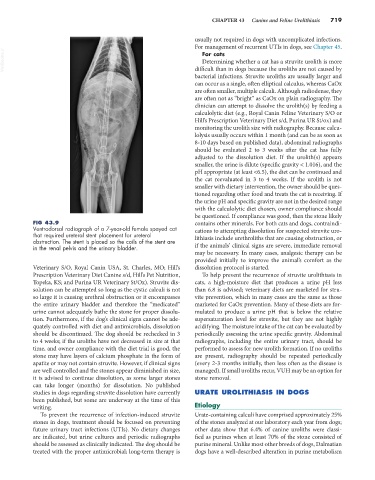Page 747 - Small Animal Internal Medicine, 6th Edition
P. 747
CHAPTER 43 Canine and Feline Urolithiasis 719
usually not required in dogs with uncomplicated infections.
For management of recurrent UTIs in dogs, see Chapter 45.
VetBooks.ir For cats
Determining whether a cat has a struvite urolith is more
difficult than in dogs because the uroliths are not caused by
bacterial infections. Struvite uroliths are usually larger and
can occur as a single, often elliptical calculus, whereas CaOx
are often smaller, multiple calculi. Although radiodense, they
are often not as “bright” as CaOx on plain radiography. The
clinician can attempt to dissolve the urolith(s) by feeding a
calculolytic diet (e.g., Royal Canin Feline Veterinary S/O or
Hill’s Prescription Veterinary Diet s/d, Purina UR St/ox) and
monitoring the urolith size with radiography. Because calcu-
lolysis usually occurs within 1 month (and can be as soon as
8-10 days based on published data), abdominal radiographs
should be evaluated 2 to 3 weeks after the cat has fully
adjusted to the dissolution diet. If the urolith(s) appears
smaller, the urine is dilute (specific gravity < 1.016), and the
pH appropriate (at least <6.5), the diet can be continued and
the cat reevaluated in 3 to 4 weeks. If the urolith is not
smaller with dietary intervention, the owner should be ques-
tioned regarding other food and treats the cat is receiving. If
the urine pH and specific gravity are not in the desired range
with the calculolytic diet chosen, owner compliance should
be questioned. If compliance was good, then the stone likely
FIG 43.9 contains other minerals. For both cats and dogs, contraindi-
Ventrodorsal radiograph of a 7-year-old female spayed cat cations to attempting dissolution for suspected struvite uro-
that required ureteral stent placement for ureteral lithiasis include urethroliths that are causing obstruction, or
obstruction. The stent is placed so the coils of the stent are
in the renal pelvis and the urinary bladder. if the animals’ clinical signs are severe, immediate removal
may be necessary. In many cases, analgesic therapy can be
provided initially to improve the animal’s comfort as the
Veterinary S/O, Royal Canin USA, St. Charles, MO; Hill’s dissolution protocol is started.
Prescription Veterinary Diet Canine s/d, Hill’s Pet Nutrition, To help prevent the recurrence of struvite urolithiasis in
Topeka, KS; and Purina UR Veterinary St/Ox). Struvite dis- cats, a high-moisture diet that produces a urine pH less
solution can be attempted so long as the cystic calculi is not than 6.8 is advised; veterinary diets are marketed for stru-
so large it is causing urethral obstruction or it encompasses vite prevention, which in many cases are the same as those
the entire urinary bladder and therefore the “medicated” marketed for CaOx prevention. Many of these diets are for-
urine cannot adequately bathe the stone for proper dissolu- mulated to produce a urine pH that is below the relative
tion. Furthermore, if the dog’s clinical signs cannot be ade- supersaturation level for struvite, but they are not highly
quately controlled with diet and antimicrobials, dissolution acidifying. The moisture intake of the cat can be evaluated by
should be discontinued. The dog should be rechecked in 3 periodically assessing the urine specific gravity. Abdominal
to 4 weeks; if the uroliths have not decreased in size at that radiographs, including the entire urinary tract, should be
time, and owner compliance with the diet trial is good, the performed to assess for new urolith formation. If no uroliths
stone may have layers of calcium phosphate in the form of are present, radiography should be repeated periodically
apatite or may not contain struvite. However, if clinical signs (every 2-3 months initially, then less often as the disease is
are well controlled and the stones appear diminished in size, managed). If small uroliths recur, VUH may be an option for
it is advised to continue dissolution, as some larger stones stone removal.
can take longer (months) for dissolution. No published
studies in dogs regarding struvite dissolution have currently URATE UROLITHIASIS IN DOGS
been published, but some are underway at the time of this
writing. Etiology
To prevent the recurrence of infection-induced struvite Urate-containing calculi have comprised approximately 25%
stones in dogs, treatment should be focused on preventing of the stones analyzed at our laboratory each year from dogs;
future urinary tract infections (UTIs). No dietary changes other data show that 6.4% of canine uroliths were classi-
are indicated, but urine cultures and periodic radiographs fied as purines when at least 70% of the stone consisted of
should be assessed as clinically indicated. The dog should be purine mineral. Unlike most other breeds of dogs, Dalmatian
treated with the proper antimicrobial; long-term therapy is dogs have a well-described alteration in purine metabolism

